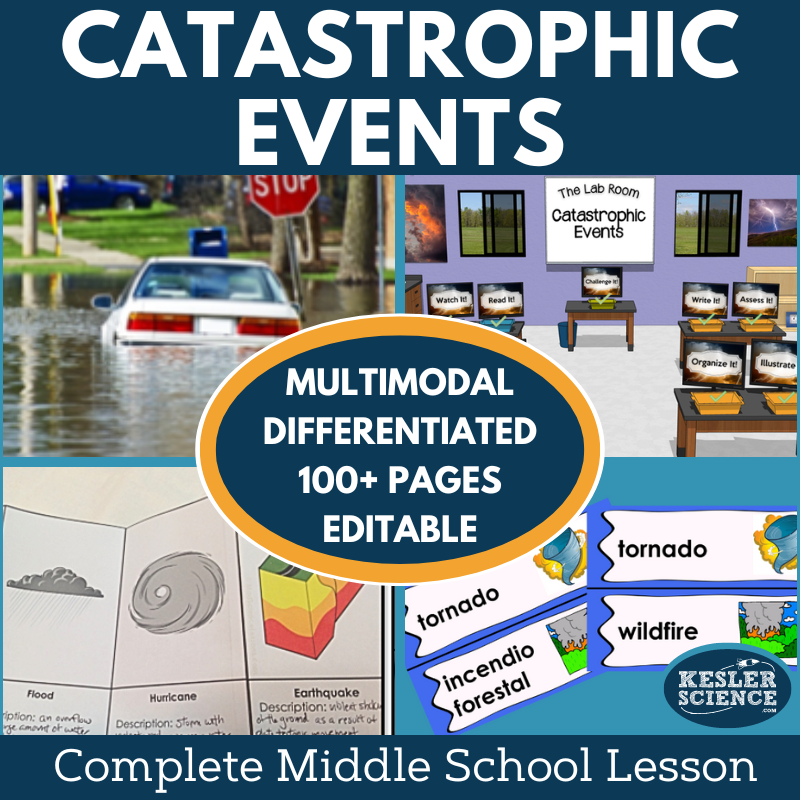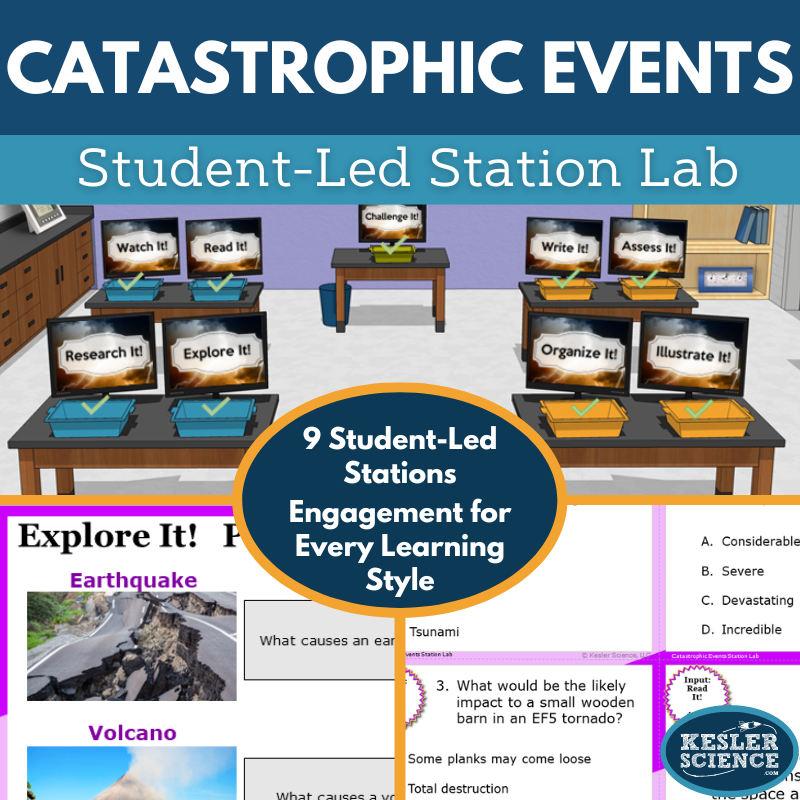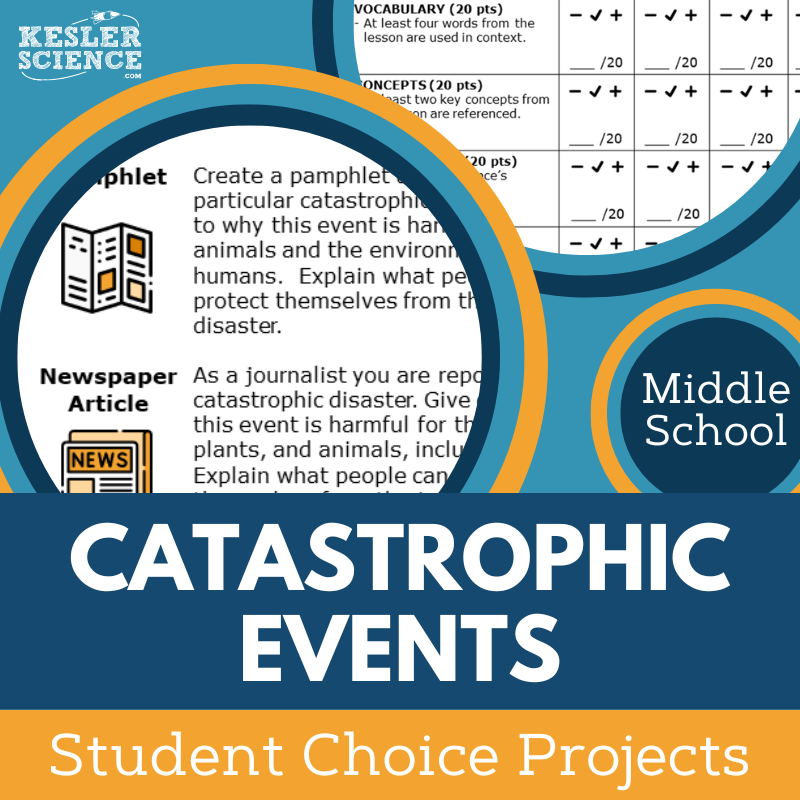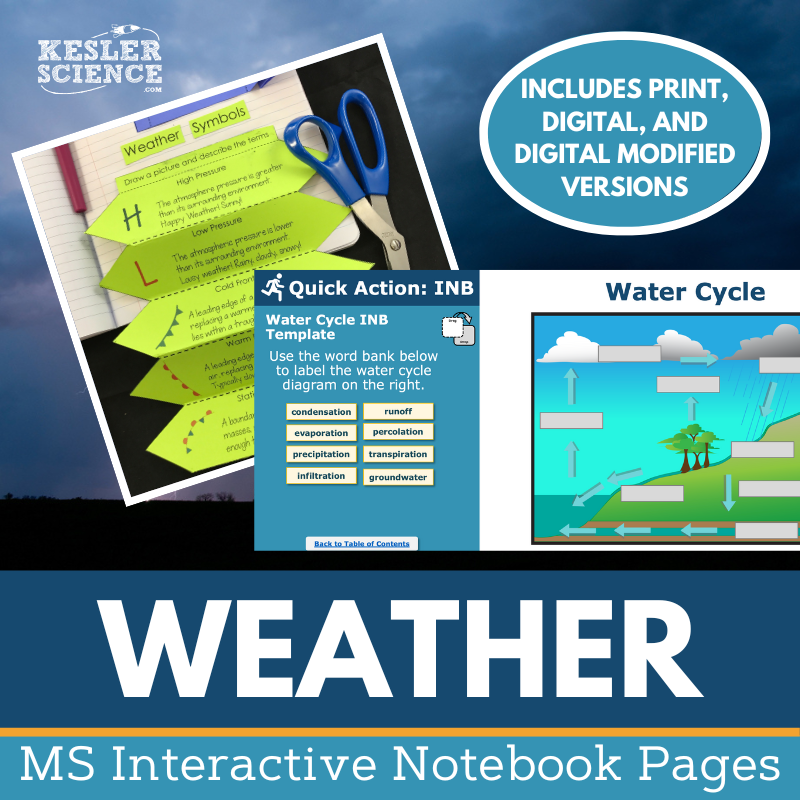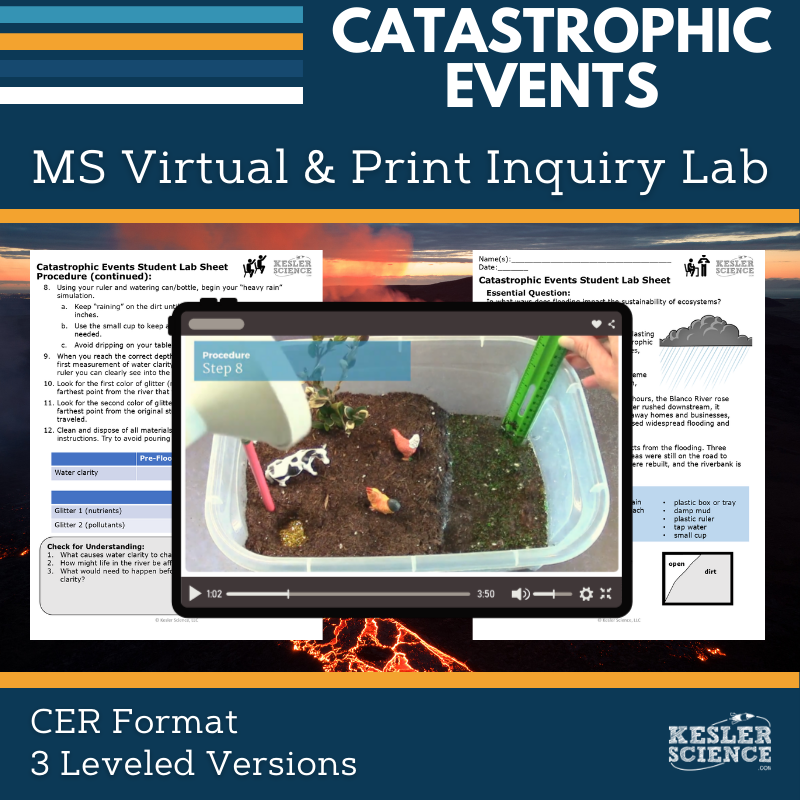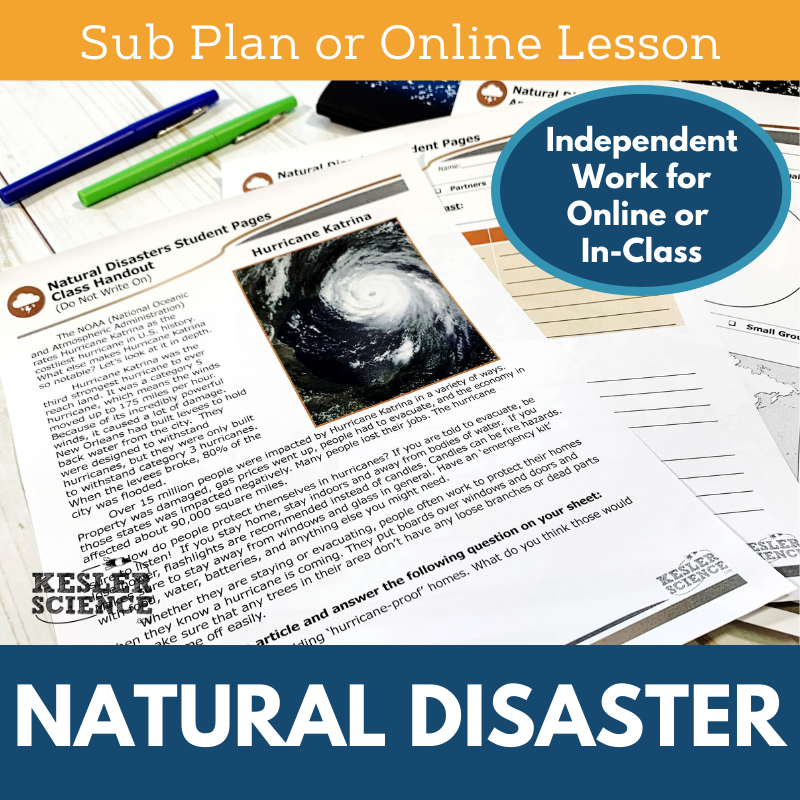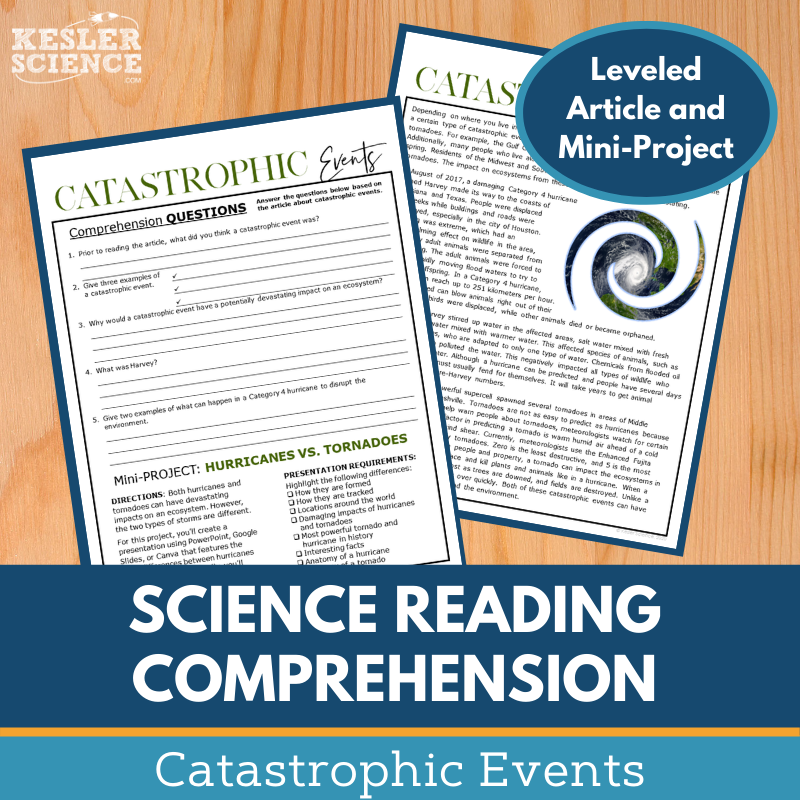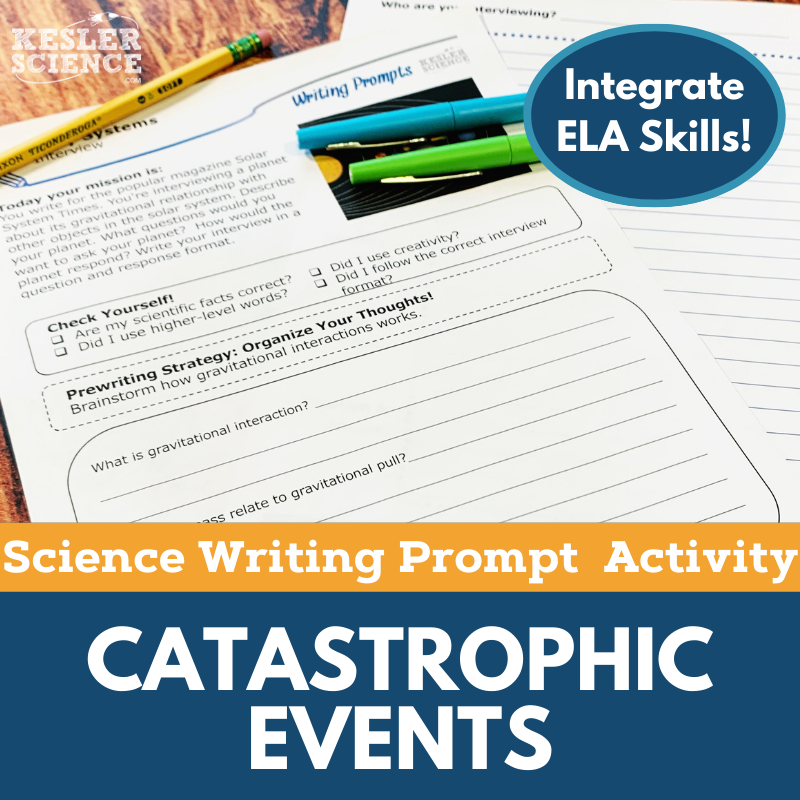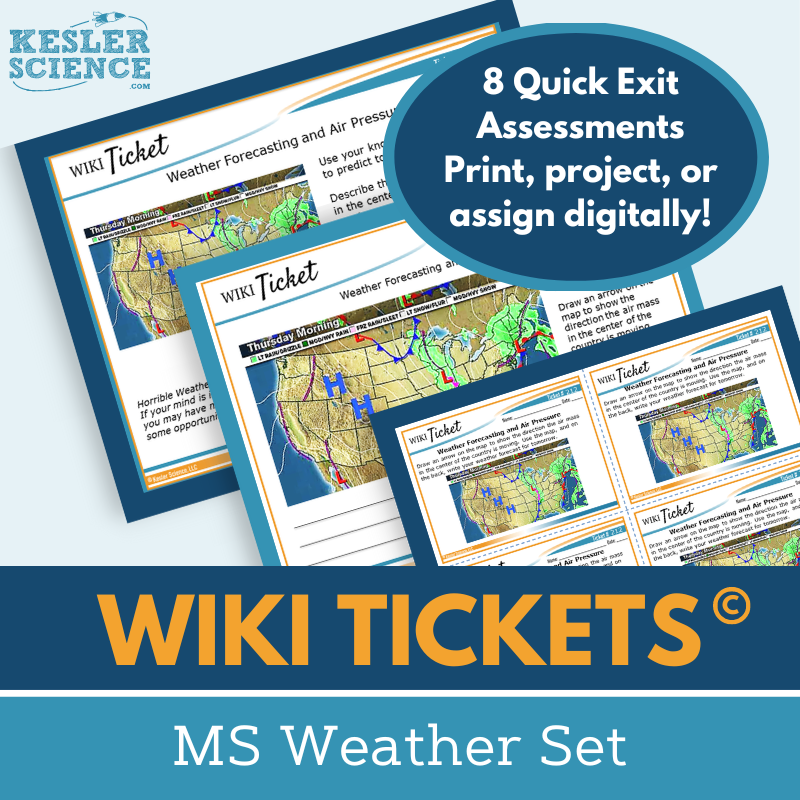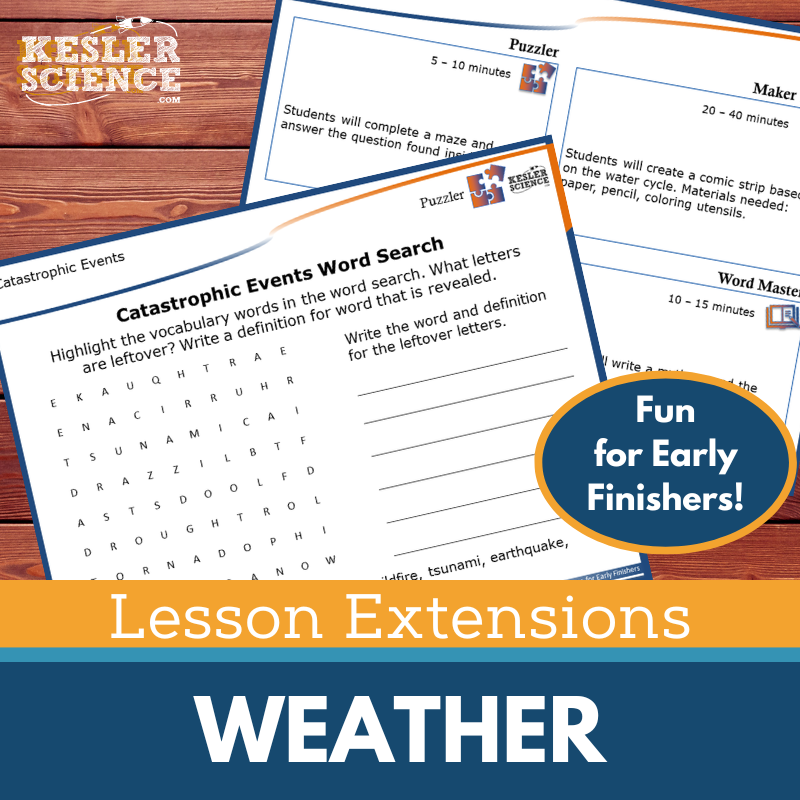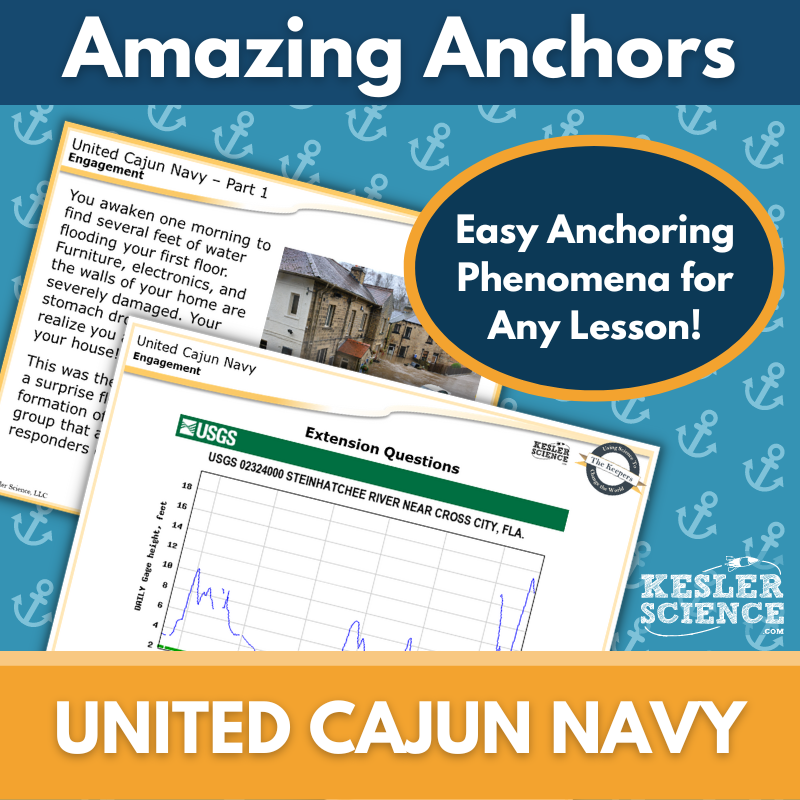Catastrophic Events Activities for Middle School Science
The Kesler Science Catastrophic Events Resources provide comprehensive, engaging materials designed to help students explore and understand natural and man-made disasters. The resources below will give students a comprehensive understanding of catastrophic events. All of the following materials are also included in the Kesler Science Membership.
The Kesler Science Catastrophic Events Complete 5E Lesson provides all the tools needed for a comprehensive middle school unit on the impact of natural disasters on ecosystems. Using the 5E Model—Engagement, Exploration, Explanation, Elaboration, and Evaluation—this lesson fosters student-led learning with minimal prep. Differentiated materials, multimodal activities, and editable resources ensure flexibility for in-person or virtual instruction. Spanish translations of vocabulary, reading passages, and interactive notebook pages support diverse classroom needs.
The Exploration phase features a nine-station lab with hands-on experiments, reading comprehension, research, and creative tasks. Stations include activities like sorting, writing, illustrating, and assessing knowledge, along with bonus challenges for early finishers. Editable PowerPoints, interactive notebook templates, and note-taking tools enhance the Explanation phase, while student-choice projects in the Elaboration phase allow for personalized, in-depth exploration.
Standards-aligned assessments, along with review questions and worksheets, provide robust Evaluation options. Whether teaching on campus or remotely, this engaging, differentiated lesson ensures students develop a deep understanding of how catastrophic events impact ecosystems.
The Kesler Science Catastrophic Events Complete 5E Lesson provides all the tools needed for a comprehensive middle school unit on the impact of natural disasters on ecosystems. Using the 5E Model—Engagement, Exploration, Explanation, Elaboration, and Evaluation—this lesson fosters student-led learning with minimal prep. Differentiated materials, multimodal activities, and editable resources ensure flexibility for in-person or virtual instruction. Spanish translations of vocabulary, reading passages, and interactive notebook pages support diverse classroom needs.
The Exploration phase features a nine-station lab with hands-on experiments, reading comprehension, research, and creative tasks. Stations include activities like sorting, writing, illustrating, and assessing knowledge, along with bonus challenges for early finishers. Editable PowerPoints, interactive notebook templates, and note-taking tools enhance the Explanation phase, while student-choice projects in the Elaboration phase allow for personalized, in-depth exploration.
Standards-aligned assessments, along with review questions and worksheets, provide robust Evaluation options. Whether teaching on campus or remotely, this engaging, differentiated lesson ensures students develop a deep understanding of how catastrophic events impact ecosystems.
The Kesler Science Catastrophic Events Station Lab engages middle school students with a modular, student-led activity that explores natural hazards and their patterns to forecast future events. This comprehensive, low-prep resource allows students to direct their learning through differentiated activities, fostering independence and critical thinking.
The lab includes nine stations, each offering a unique approach to learning. Input stations, like "Explore It!", "Research It!", "Read It!", and "Watch It!", introduce concepts through hands-on demonstrations, readings, videos, and research tasks. Output stations, such as "Organize It!", "Illustrate It!", "Write It!", and "Assess It!", enable students to demonstrate their knowledge in creative, multimodal ways, with a bonus "Challenge It!" station for early finishers.
Designed for both in-person and virtual learning, the lab includes all necessary resources, signage, and task cards. Teachers can facilitate learning while students work independently or in small groups. Differentiated passages, bilingual materials, and flexible digital options ensure accessibility for all learners.
The Kesler Science Catastrophic Events Station Lab engages middle school students with a modular, student-led activity that explores natural hazards and their patterns to forecast future events. This comprehensive, low-prep resource allows students to direct their learning through differentiated activities, fostering independence and critical thinking.
The lab includes nine stations, each offering a unique approach to learning. Input stations, like "Explore It!", "Research It!", "Read It!", and "Watch It!", introduce concepts through hands-on demonstrations, readings, videos, and research tasks. Output stations, such as "Organize It!", "Illustrate It!", "Write It!", and "Assess It!", enable students to demonstrate their knowledge in creative, multimodal ways, with a bonus "Challenge It!" station for early finishers.
Designed for both in-person and virtual learning, the lab includes all necessary resources, signage, and task cards. Teachers can facilitate learning while students work independently or in small groups. Differentiated passages, bilingual materials, and flexible digital options ensure accessibility for all learners.
The Kesler Science Catastrophic Events Student Choice Projects allow middle school students to demonstrate their understanding of natural disasters in creative ways. Students choose from six project options or design their own, allowing for personalized learning and a variety of outputs. A detailed grading rubric enables assessments by teachers, peers, or students themselves, ensuring accountability and clarity.
These flexible projects are designed to accommodate different learning needs. Two versions of the project page are included, with a modified version providing targeted support for students requiring remediation. For advanced learners, teachers can assign a combination of projects to deepen engagement, all while using the same adaptable rubric.
The materials needed are common classroom supplies like paper, markers, and scissors, with optional crafting materials for building models. Projects can also be completed digitally, making them ideal for in-person and virtual learning environments. Teacher directions and editable rubrics further support ease of use and customization.
The Kesler Science Catastrophic Events Student Choice Projects allow middle school students to demonstrate their understanding of natural disasters in creative ways. Students choose from six project options or design their own, allowing for personalized learning and a variety of outputs. A detailed grading rubric enables assessments by teachers, peers, or students themselves, ensuring accountability and clarity.
These flexible projects are designed to accommodate different learning needs. Two versions of the project page are included, with a modified version providing targeted support for students requiring remediation. For advanced learners, teachers can assign a combination of projects to deepen engagement, all while using the same adaptable rubric.
The materials needed are common classroom supplies like paper, markers, and scissors, with optional crafting materials for building models. Projects can also be completed digitally, making them ideal for in-person and virtual learning environments. Teacher directions and editable rubrics further support ease of use and customization.
The Kesler Science Weather Interactive Notebook Bundle offers both print and digital versions to enhance student engagement while teaching key weather concepts. Perfect for traditional classrooms, 1:1 settings, or distance learning, this bundle covers important topics such as the atmosphere, catastrophic events, convection currents, hurricane formation, the water cycle, and weather maps.
Digital versions include a customizable PowerPoint file that can be uploaded to Google Slides or integrated into platforms like MS Teams, Schoology, and Canvas. It also features reflection pages, spaces for student notes, and a modified version for students with accommodations, all supported by a teacher answer key.
The paper version includes complete blank templates for the interactive notebook, pre-filled versions for students needing modifications or those who missed class, and color photos that demonstrate how each template is used, making it a versatile tool for teachers and students alike.
The Kesler Science Weather Interactive Notebook Bundle offers both print and digital versions to enhance student engagement while teaching key weather concepts. Perfect for traditional classrooms, 1:1 settings, or distance learning, this bundle covers important topics such as the atmosphere, catastrophic events, convection currents, hurricane formation, the water cycle, and weather maps.
Digital versions include a customizable PowerPoint file that can be uploaded to Google Slides or integrated into platforms like MS Teams, Schoology, and Canvas. It also features reflection pages, spaces for student notes, and a modified version for students with accommodations, all supported by a teacher answer key.
The paper version includes complete blank templates for the interactive notebook, pre-filled versions for students needing modifications or those who missed class, and color photos that demonstrate how each template is used, making it a versatile tool for teachers and students alike.
The Kesler Science Catastrophic Events Inquiry Lab aligns with middle school science standards by helping students explore the effects of catastrophic flooding on ecosystems. Students can engage with either a hands-on printed lab or a fully interactive digital version. Both formats include comprehension checks, C.E.R. prompts, and reflection sections to support student learning.
In the hands-on lab, students use materials like mud, models of houses and trees, and glitter to simulate a riverbank ecosystem and observe the effects of rising water. They begin by building and describing their ecosystem, then simulate a flood and record changes, making predictions and observations throughout. The digital version offers the same investigative experience without the need for physical materials, making it ideal for absent students or classrooms with limited supplies.
Each version of the lab comes in three differentiated levels—dependent, modified, and independent—to accommodate diverse learning needs. Teachers receive editable resources, answer keys, and comprehensive guidance to streamline instruction. The lab is fully compatible with Google Slides and provides a multimodal, flexible approach to engage all learners in science exploration.
The Kesler Science Catastrophic Events Inquiry Lab aligns with middle school science standards by helping students explore the effects of catastrophic flooding on ecosystems. Students can engage with either a hands-on printed lab or a fully interactive digital version. Both formats include comprehension checks, C.E.R. prompts, and reflection sections to support student learning.
In the hands-on lab, students use materials like mud, models of houses and trees, and glitter to simulate a riverbank ecosystem and observe the effects of rising water. They begin by building and describing their ecosystem, then simulate a flood and record changes, making predictions and observations throughout. The digital version offers the same investigative experience without the need for physical materials, making it ideal for absent students or classrooms with limited supplies.
Each version of the lab comes in three differentiated levels—dependent, modified, and independent—to accommodate diverse learning needs. Teachers receive editable resources, answer keys, and comprehensive guidance to streamline instruction. The lab is fully compatible with Google Slides and provides a multimodal, flexible approach to engage all learners in science exploration.
The Kesler Science Natural Disaster Sub Plans guide students through a complete lesson on hurricanes and tornadoes, beginning with an engaging warm-up activity. Students read an informational passage and apply their knowledge by designing a hurricane-proof house, combining creativity and critical thinking.
For early finishers, extension activities include creating a Venn diagram comparing hurricanes and tornadoes or mapping locations prone to these natural disasters. The lesson concludes with an assessment or exit ticket to evaluate understanding. Extensive substitute instructions and a digital Google Form option make this lesson perfect for in-person or distance learning.
These student-centered sub plans are designed to remove downtime and ensure seamless learning, even in the teacher's absence. With editable resources, behavior checkpoints, and digital adaptability, they’re ideal for sub plans, remote learning, or reinforcement activities. Teachers can rely on these thoughtfully crafted plans to keep students engaged and on track.
The Kesler Science Natural Disaster Sub Plans guide students through a complete lesson on hurricanes and tornadoes, beginning with an engaging warm-up activity. Students read an informational passage and apply their knowledge by designing a hurricane-proof house, combining creativity and critical thinking.
For early finishers, extension activities include creating a Venn diagram comparing hurricanes and tornadoes or mapping locations prone to these natural disasters. The lesson concludes with an assessment or exit ticket to evaluate understanding. Extensive substitute instructions and a digital Google Form option make this lesson perfect for in-person or distance learning.
These student-centered sub plans are designed to remove downtime and ensure seamless learning, even in the teacher's absence. With editable resources, behavior checkpoints, and digital adaptability, they’re ideal for sub plans, remote learning, or reinforcement activities. Teachers can rely on these thoughtfully crafted plans to keep students engaged and on track.
The Kesler Science Catastrophic Events Reading Comprehension Activity engages middle school students with a nonfiction article about hurricanes and tornadoes, followed by comprehension questions and a mini-project comparing the two phenomena. This hands-on approach builds science literacy and critical thinking skills, making it ideal for grades 6–8 and advanced 5th graders.
The resource includes leveled reading passages (Lexile 1100–1300), comprehension questions, and a creative mini-project. Additional tools like a Cornell notes template and colorful graphics make the lesson adaptable for diverse learning styles. Designed for flexibility, it works well for in-class, remote, or blended learning environments, integrating seamlessly with Google Classroom, MS Teams, and other platforms.
This versatile activity is perfect for absent students, extra credit, sub plans, or whole-class instruction. Teachers can use it to spark discussions, improve reading comprehension, and enhance students' ability to analyze scientific text. With engaging content and practical applications, the lesson provides a dynamic way to explore catastrophic events.
The Kesler Science Catastrophic Events Reading Comprehension Activity engages middle school students with a nonfiction article about hurricanes and tornadoes, followed by comprehension questions and a mini-project comparing the two phenomena. This hands-on approach builds science literacy and critical thinking skills, making it ideal for grades 6–8 and advanced 5th graders.
The resource includes leveled reading passages (Lexile 1100–1300), comprehension questions, and a creative mini-project. Additional tools like a Cornell notes template and colorful graphics make the lesson adaptable for diverse learning styles. Designed for flexibility, it works well for in-class, remote, or blended learning environments, integrating seamlessly with Google Classroom, MS Teams, and other platforms.
This versatile activity is perfect for absent students, extra credit, sub plans, or whole-class instruction. Teachers can use it to spark discussions, improve reading comprehension, and enhance students' ability to analyze scientific text. With engaging content and practical applications, the lesson provides a dynamic way to explore catastrophic events.
The Kesler Science Catastrophic Events Writing Prompt Activity gives middle school students a creative and engaging way to explore earth science concepts. Using a call-to-action format, this activity extends science reasoning and writing skills while keeping students actively involved in the topic of catastrophic events. Designed for in-person and virtual learning, the activity ensures all students can participate seamlessly.
The writing prompt package includes teacher directions, answer guides, rubrics, and both full- and half-sheet handouts for flexibility. A digital version, compatible with PowerPoint and Google Slides, allows for easy integration into learning management systems. Students can enhance their understanding through pre-writing strategies, self-checks, and reflection exercises.
This versatile resource can be used as a cross-curricular activity, formative assessment, student choice project, or extension for early finishers. Whether for extra credit, make-up work, or differentiation, the Catastrophic Events Writing Prompt Activity provides a fun and meaningful way to enrich science learning.
The Kesler Science Catastrophic Events Writing Prompt Activity gives middle school students a creative and engaging way to explore earth science concepts. Using a call-to-action format, this activity extends science reasoning and writing skills while keeping students actively involved in the topic of catastrophic events. Designed for in-person and virtual learning, the activity ensures all students can participate seamlessly.
The writing prompt package includes teacher directions, answer guides, rubrics, and both full- and half-sheet handouts for flexibility. A digital version, compatible with PowerPoint and Google Slides, allows for easy integration into learning management systems. Students can enhance their understanding through pre-writing strategies, self-checks, and reflection exercises.
This versatile resource can be used as a cross-curricular activity, formative assessment, student choice project, or extension for early finishers. Whether for extra credit, make-up work, or differentiation, the Catastrophic Events Writing Prompt Activity provides a fun and meaningful way to enrich science learning.
The Kesler Science Weather WIKI Tickets are engaging formative assessments designed for 6th-8th grade science topics, offering flexible options for checking student understanding. The Weather Set includes eight WIKI Tickets, each aligned to NGSS and TEKS standards, with five format choices: a projection version, three handout sizes (full, split, and quarter-page), and a digital version (editable PPT or Google Slides). These assessments provide a fun, interactive way to gauge student learning.
The WIKI Tickets can be used as exit tickets, bellringers, or during lessons to quickly assess students' grasp of concepts such as the water cycle, weather maps, and ocean currents. Each ticket helps reinforce key topics, ensuring that students are meeting learning goals in a creative, low-pressure way. A bonus table of contents file is included for easy reference to ensure standards alignment.
Perfect for both in-person and virtual learning, these assessments allow for seamless integration into various classroom settings. Whether projected in class or completed digitally, WIKI Tickets help educators gauge student progress and adapt instruction to meet their needs.
The Kesler Science Weather WIKI Tickets are engaging formative assessments designed for 6th-8th grade science topics, offering flexible options for checking student understanding. The Weather Set includes eight WIKI Tickets, each aligned to NGSS and TEKS standards, with five format choices: a projection version, three handout sizes (full, split, and quarter-page), and a digital version (editable PPT or Google Slides). These assessments provide a fun, interactive way to gauge student learning.
The WIKI Tickets can be used as exit tickets, bellringers, or during lessons to quickly assess students' grasp of concepts such as the water cycle, weather maps, and ocean currents. Each ticket helps reinforce key topics, ensuring that students are meeting learning goals in a creative, low-pressure way. A bonus table of contents file is included for easy reference to ensure standards alignment.
Perfect for both in-person and virtual learning, these assessments allow for seamless integration into various classroom settings. Whether projected in class or completed digitally, WIKI Tickets help educators gauge student progress and adapt instruction to meet their needs.
The Kesler Science Lesson Extensions provide engaging, rigorous activities designed to challenge fast finishers and deepen student understanding. These extensions offer a variety of options, including puzzles, hands-on maker space activities, tech connections, and creative writing, all linked to the weather standards of NGSS and TEKS. Whether you're looking to end a lesson or fill gaps during testing, these activities keep students actively learning while promoting critical thinking.
Each extension includes teacher directions, answer keys, and printable or digital versions for easy classroom integration. The diverse formats allow students to work individually or collaborate, fostering creativity and independent learning. The resources are ideal for pushing students who are ready for more advanced learning, encouraging them to explore topics like catastrophic events, hurricane formation, and the water cycle.
Perfect for use with any of the Kesler Science weather lessons, these extensions help reinforce key concepts while offering a fun and meaningful challenge. With options for both digital and paper use, they are a flexible way to scaffold learning and support students’ growth.
The Kesler Science Lesson Extensions provide engaging, rigorous activities designed to challenge fast finishers and deepen student understanding. These extensions offer a variety of options, including puzzles, hands-on maker space activities, tech connections, and creative writing, all linked to the weather standards of NGSS and TEKS. Whether you're looking to end a lesson or fill gaps during testing, these activities keep students actively learning while promoting critical thinking.
Each extension includes teacher directions, answer keys, and printable or digital versions for easy classroom integration. The diverse formats allow students to work individually or collaborate, fostering creativity and independent learning. The resources are ideal for pushing students who are ready for more advanced learning, encouraging them to explore topics like catastrophic events, hurricane formation, and the water cycle.
Perfect for use with any of the Kesler Science weather lessons, these extensions help reinforce key concepts while offering a fun and meaningful challenge. With options for both digital and paper use, they are a flexible way to scaffold learning and support students’ growth.
This Amazing Anchors Phenomenon Lesson introduces the effects of severe weather on ecosystems through a real-world lens. Students begin with an engaging reading based on the United Cajun Navy, followed by comprehension and extension questions that activate prior knowledge and set the stage for further learning. A second reading explains the science behind how severe weather influences ecosystems, helping students connect the phenomenon to scientific principles.
The resource includes everything needed to support instruction, such as teacher directions with answer keys, editable materials, and both print and digital formats for flexible classroom use. Projection slides and paper handouts are provided in full and half-sheet formats, making them easy to integrate into interactive notebooks or use with classroom displays.
Designed to support the Engagement and Elaboration phases of the 5E Model, this no-prep, TEKS-aligned lesson includes two differentiated reading versions. The modified version supports student comprehension with simplified language and sentence starters, ensuring accessibility for all learners in both in-person and virtual learning environments.
This Amazing Anchors Phenomenon Lesson introduces the effects of severe weather on ecosystems through a real-world lens. Students begin with an engaging reading based on the United Cajun Navy, followed by comprehension and extension questions that activate prior knowledge and set the stage for further learning. A second reading explains the science behind how severe weather influences ecosystems, helping students connect the phenomenon to scientific principles.
The resource includes everything needed to support instruction, such as teacher directions with answer keys, editable materials, and both print and digital formats for flexible classroom use. Projection slides and paper handouts are provided in full and half-sheet formats, making them easy to integrate into interactive notebooks or use with classroom displays.
Designed to support the Engagement and Elaboration phases of the 5E Model, this no-prep, TEKS-aligned lesson includes two differentiated reading versions. The modified version supports student comprehension with simplified language and sentence starters, ensuring accessibility for all learners in both in-person and virtual learning environments.
Year-Round Resources
These year-round activities will increase your students' understanding of many middle school science topics. All of these activities are also included in the Kesler Science Membership.
Visual Data & Graphing
You're not alone if your students struggle with understanding graphs, charts, and tables. It's a skill that takes an enormous amount of practice. This resource will help students build a strong foundation in analyzing data and creating their own data visualizations.
Bell Ringers and Warm-Ups
These middle school science bell ringers are an excellent way to engage your students as soon as they walk into your classroom. This comprehensive FULL YEAR resource includes everything you need to start off each science class with an interesting warm-up activity.
Review Board Games
Each game board has been carefully designed to keep students engaged. There are 10 different action spaces on each board and dozens of question cards. All of the actions are related to science concepts and keep the students motivated throughout the game.
Each game is ready to play. Simply print out the board and the cards and let the students enjoy reviewing nine different units.
Essential Questions
Below are the essential questions associated with the lessons and activities included in this unit. This topic is only one of more than 100 middle school science topics included in the Kesler Science Membership.
-
Can you predict and describe how different types of catastrophic events impact ecosystems?
Kesler Science Membership
Imagine never having to search for another middle school science lesson again. The membership gives you access to ALL of the Kesler Science products in one place (Yes, including everything above).
Say goodbye to long hours of lesson prep.

